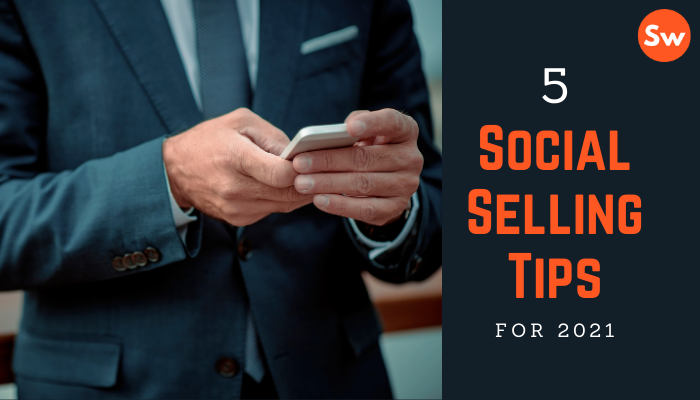Back in the 1980s, social selling meant scheduling steakhouse dinners, hitting the golf course, networking at business conferences and, when all else failed, cold calling and canvassing.
In today’s digital world, these methods are considered either outdated, inefficient, or both.
And now, in a pandemic, face-to-face social networking opportunities are scarce regardless.

On the other hand, many business-owners feel out of touch when it comes to selling online. Practices like SEO, targeted advertising, and consistent content creation can be time-consuming efforts that end up being hit or miss at the end of the day.
These strategies are also mostly defensive, meaning that our clients are stuck waiting for a qualified prospect to magically knock on their digital door. Not only is this frustrating, but it also makes for a bone dry sales pipeline.
With all this at play, the question becomes: how do business-owners craft an outbound, conversation-oriented prospecting strategy that isn’t old-fashioned or ineffective?
The answer is social selling. Since cold-calling, lead-generation software (like LinkedIn) has allowed us to gain more information about our prospects before putting in the labor to court them. That satisfies the goal of efficiency.
Social Selling is the practice of messaging or otherwise interacting with potential leads on social media with the aim of widening your client base.

In addition to courting the right people, social selling also allows us to build casual, natural rapport with our prospects before pitching the product. This satisfies the goal of a conversational approach.
Even with these qualifiers, social selling is still the younger, hipper nephew of cold-calling—but that doesn’t necessarily mean you should count it out as old-fashioned.
Social selling takes the age old practice of cold-calling and adapts it to today’s standards.
That’s why it works.
Time and time again, we field skeptical questions from our clients here at Speedwork. Since many of them are CEOs, founders, and business-owners themselves, they know what it’s like to have an inbox full of sales messages and emails, and they know how unlikely they are to respond to them.
However, after as little as 14 days running their social selling campaigns with us, our clients get the responses and meetings that make for a pleasant surprise.
Here are the top 5 tips we go over in pre-launch meetings with new social sellers.
1. Start a conversation before you pitch.
Have you ever received a sales email that requires you to scroll before getting to the point? Most of us have. They’re rarely successful, because the recipient would need both patience and empathy for the sender in order to respond. Plus, text walls don’t feel warm or inviting.
Instead of bombarding our prospects with a jargony, hard-to-read text block, we lead them into conversation naturally—like a real person would. However our clients, excited and inspired by their businesses, often have the instinct to frontload with as much impressive information as possible when speaking with a new connection.
It’s natural to want to share the shiny statistics, boast about their ROI, and revel in the genius of their intelligent solutions. These are all good instincts—but they’re poorly placed.
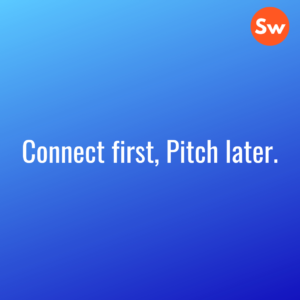
See, the goal of social selling is not usually to boost brand awareness (although that’s a nice side benefit). The goal of a social selling strategy is to find qualified leads, and then to set appointments.
Instead of serving our prospects a complex feast of information, we need to drop a trail of breadcrumbs that leads them gently and unassumingly into our client’s booking link.
Rarely will a social seller start a message with: “Thanks for connecting! Our company made $4 million dollars for clients in the industry last year!”
Instead, they’ll gently prod. “Nice to meet you! Does your company struggle with XYZ?”
2. Don’t waste time on unqualified prospects. (Targeting, Targeting, Targeting!)
All too often, people view interpersonal sales efforts as lame, cheesy, or overly transparent. They put themselves in the prospect’s shoes and they think they’d clock the sales pitch from a mile away. And the thing is—our prospects probably know what’s coming too. The difference is that they don’t mind entertaining it.
This common doubt is born out of the client’s assumption that people don’t like being pitched. But people do like being pitched. They actually do want to learn about interesting industry solutions and potential partners. The tipping point is whether the service or product being sold is one they could actually use.
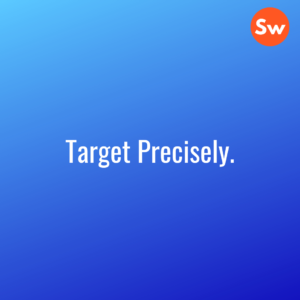
So, the reason we answer this question with a resounding yes is that we only sell our clients’ services to people who need them. If real estate’s mantra is location, location, location, then social selling’s would be targeting, targeting, targeting.
Before the first connect request, message, or content share is ever sent, a successful social seller will strategically pare down a crowd of millions into a crowd of just a few thousand, all of whom could realistically make use of whatever they’re peddling.
We don’t sell standing desks to construction workers, and we don’t sell umbrellas to people in L.A. We complete the necessary filter work on the backend so that our sales pitches are intriguing, timely, and relevant to the prospects who receive them.
3. Don’t sell yourself short: Aim High.
When you’re just looking at profile pictures, it’s common to imagine your ideal prospects as inaccessible, suit-donning gods of the industry, A.K.A. people who would never have time to actually speak with them. And sure, it makes sense to think that an executive in an active company wouldn’t have time to monitor their InMail, much less care enough to do so. But, as with most things in life, the reality is often much less glamorous than we imagine.
As admirable as the titles CEO, Founder, and Owner might seem, we would do well to remember that the people who carry them are only just that: people. They’re people who mindlessly scroll, and they’re people who likely rose up the ranks due to the same scrappy, straightforward sales efforts as the ones we’re using to connect with them.
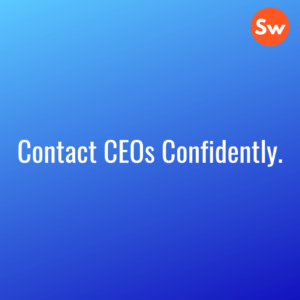
CEOs are on LinkedIn likely for a similar reason as yourself. They want to be leaders in their company, thought leaders in their industry, and up to date. What better way to do this than sharing updates about their company, successes, and interacting with colleagues and their own customers?
It’s easy for a seller to assume that they’re a burden on their prospects, and to assume a meek posture as a result. Unfortunately, if you treat your message as though it’s a burden on your prospect, they’ll see it that way too.
The most effective outreaches march into their inboxes with confidence, direction, and efficient communication. You’d be surprised how many CEOs are willing to claim a meeting slot on our clients’ Calendly widgets.
4. Realize social media’s potential post-pandemic.
We’ll give you the bad news first: sometimes, your target buyers won’t be using social media sites. When it comes to stay-at-home moms, blue collar workers, or people of a certain age, we can’t always guarantee a high engagement rate on a professional networking social site like LinkedIn.
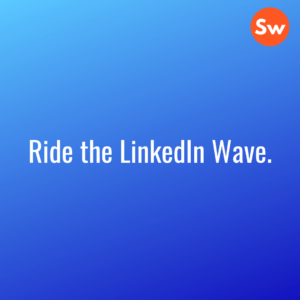
Now for the good news! If you’re following our targeting mantra, you’ll never make it to the pre-launch stage without being positive that you can actually generate leads.
Since the pandemic, LinkedIn has been hitting record numbers when it comes to new accounts and post engagements. We’re officially in the era of remote work, and to be quite frank: LinkedIn is where it’s all happening.
5. Keep it simple.
The thing about social selling is that most of our interactions with a prospect take place in social media apps on their smartphones. This particular venue is engineered for short, efficient soundbites with significant forward momentum.
Considering our medium, every single message we send should feel effortless to read on a 6 inch screen. That means we should be sparing with emoji or formatting play, and certainly use as few hyperlinks as possible. At first, this can seem counterintuitive to the client. They might think that the condensed space available to us means we should use more links and credibility statements.
The answer is quite simple: it’s not about you. The quickest way to kill a connection with a new person on LinkedIn is to talk too much about yourself, because the bottom line is that your prospects aren’t yet invested in who you are as a company—they’re only invested in themselves.

This means that instead of packing our messages to the gills with links, case studies, percentages and name-drops, we have to redirect the spotlight onto the prospect. If you’ve heard it once, you’ve heard it a hundred times: everyone’s favorite word is their own name.
It all comes down to one simple question: Would you rather talk about your product or sell your product? Of course, we already know the answer.
It’s better to adapt the means to accomplish the ultimate end—making a sale.
And when it comes to making sales happen, social selling works.
It works precisely because we think it won’t.
Because today, the marketing trends are poise, polish and perfection—so when a scrappy social seller pings your inbox, you’ll be totally caught off guard.
Who knows? You may even be a bit charmed.
